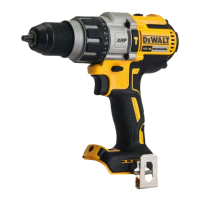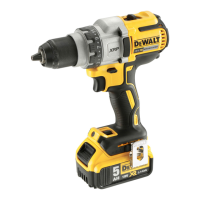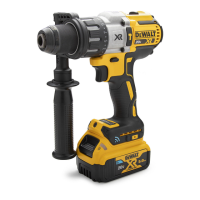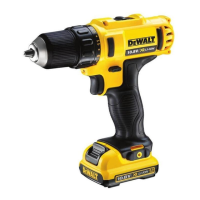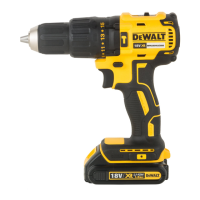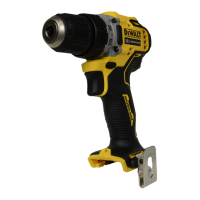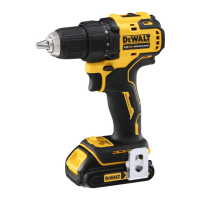6
ENGLISH
If the supply cord is damaged, it must be replaced only by
DeWALT or an authorised serviceorganisation.
Mains Plug Replacement
(U.K.& Ireland Only)
If a new mains plug needs to be fitted:
• Safely dispose of the oldplug.
• Connect the brown lead to the live terminal in theplug.
• Connect the blue lead to the neutralterminal.
WARNING: No connection is to be made to the
earthterminal.
Follow the fitting instructions supplied with good quality plugs.
Recommended fuse: 3A.
Using an Extension Cable
An extension cord should not be used unless absolutely
necessary. Use an approved extension cable suitable for
the power input of your charger (see Technical Data). The
minimum conductor size is 1mm
2
; the maximum length
is30m.
When using a cable reel, always unwind the cablecompletely.
Important Safety Instructions for All
BatteryChargers
SAVE THESE INSTRUCTIONS: This manual contains important
safety and operating instructions for compatible battery
chargers (refer to TechnicalData).
• Before using charger, read all instructions and cautionary
markings on charger, battery pack, and product using
batterypack.
WARNING: Shock hazard. Do not allow any liquid to get
inside charger. Electric shock mayresult.
WARNING: We recommend the use of a residual current
device with a residual current rating of 30mA orless.
CAUTION: Burn hazard. To reduce the risk of injury,
charge only DeWALT rechargeable batteries. Other
types of batteries may burst causing personal injury
anddamage.
CAUTION: Children should be supervised to ensure that
they do not play with theappliance.
NOTICE: Under certain conditions, with the charger
plugged into the power supply, the exposed charging
contacts inside the charger can be shorted by foreign
material. Foreign materials of a conductive nature such
as, but not limited to, steel wool, aluminum foil or any
buildup of metallic particles should be kept away from
charger cavities. Always unplug the charger from the
power supply when there is no battery pack in the cavity.
Unplug charger before attempting toclean.
• DO NOT attempt to charge the battery pack with any
chargers other than the ones in this manual. The charger
and battery pack are specifically designed to worktogether.
• These chargers are not intended for any uses other than
charging DeWALT rechargeable batteries. Any other uses
may result in risk of fire, electric shock orelectrocution.
• Do not expose charger to rain orsnow.
Chargers
DeWALT chargers require no adjustment and are designed to be
as easy as possible tooperate.
Electrical Safety
The electric motor has been designed for one voltage only.
Always check that the battery pack voltage corresponds to the
voltage on the rating plate. Also make sure that the voltage of
your charger corresponds to that of yourmains.
i
Your DeWALT charger is double insulated in
accordance with EN60335; therefore no earth wire
isrequired.
Residual Risks
In spite of the application of the relevant safety regulations
and the implementation of safety devices, certain residual risks
cannot be avoided. These are:
• Impairment ofhearing.
• Risk of personal injury due to flyingparticles.
• Risk of burns due to accessories becoming hot
duringoperation.
• Risk of personal injury due to prolongeduse.
SAVE THESE INSTRUCTIONS
contacting a “live” wire may make exposed metal parts of the
power tool “live” and could give the operator an electricshock.
Safety Instructions When Using Long
Drill Bits
• Never operate at higher speed than the maximum
speed rating of the drill bit. At higher speeds, the bit is likely
to bend if allowed to rotate freely without contacting the
workpiece, resulting in personalinjury.
• Always start drilling at low speed and with the bit tip
in contact with the workpiece. At higher speeds, the bit is
likely to bend if allowed to rotate freely without contacting the
workpiece, resulting in personalinjury.
• Apply pressure only in direct line with the bit and do not
apply excessive pressure. Bits can bend causing breakage or
loss of control, resulting in personalinjury.
• Use clamps or other practical way to secure and support
the workpiece to a stable platform. Holding the work by
hand or against your body is unstable and may lead to loss
ofcontrol.
• Wear ear protectors when hammering for extended
periods of time. Prolonged exposure to high intensity noise
can cause hearing loss. Temporary hearing loss or serious ear
drum damage may result from high sound levels generated
byhammerdrilling.
• Wear safety goggles or other eye protection. Hammering
and drilling operations cause chips to fly. Flying particles can
cause permanent eyedamage.
• Hammer bits and tools get hot during operation. Wear
gloves when touchingthem.

